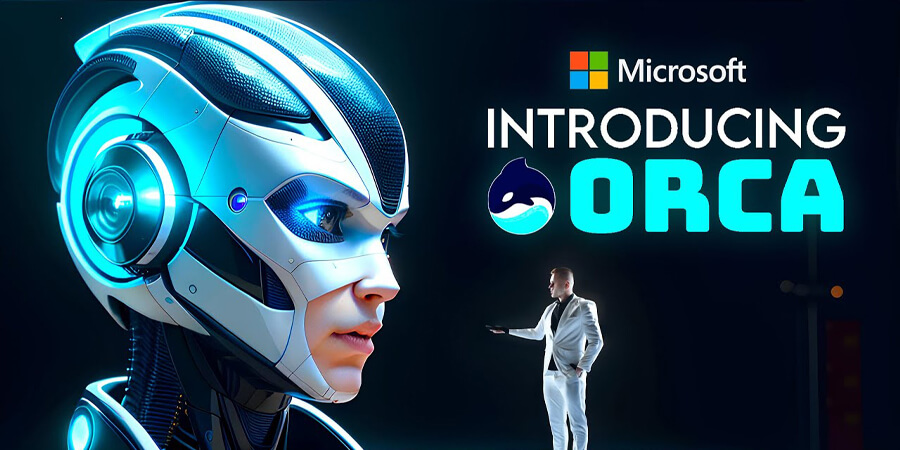To keep pace with other industry giants like Google, Microsoft is making substantial investments in AI. Through its collaboration with OpenAI, Microsoft has emerged as a frontrunner in integrating AI capabilities into its product portfolio while also focusing on the development of smaller, specialized models.
Meet Orca
As part of this ongoing commitment, Microsoft Research recently unveiled a groundbreaking AI model called Orca. Designed to leverage the learning potential of large language models through imitation, Orca addresses the limitations faced by smaller models. By imitating the reasoning processes of expansive foundation models like GPT-4 and incorporating valuable insights such as explanation traces, step-by-step thought processes and complex instructions, Orca, with its impressive 13 billion parameters, aims to surpass existing state-of-the-art models. This innovative approach effectively bridges the gap between smaller and larger models, advancing AI research capabilities and performance.
Orca's development emphasizes the importance of progressive learning by utilizing large-scale and diverse imitation data. By implementing judicious sampling and selection techniques, Orca overcomes the limitations of previous models. By learning from step-by-step explanations generated by both humans and advanced AI models, Orca significantly enhances its own capabilities and skills.
The efficacy of Orca is powerfully demonstrated through a series of rigorous benchmarks and evaluations. In complex zero-shot reasoning benchmarks such as Big-Bench Hard (BBH), Orca outperforms traditional state-of-the-art instruction-tuned models such as Vicuna-13B by a margin of over 100%. Moreover, Orca showcases remarkable performance in professional and academic examinations like the SAT, LSAT, GRE and GMAT, achieving a notable 4-point advantage with optimized system messages. Notably, Oeca achieves parity with ChatGPT on the BBH benchmark, showcasing its exceptional ability to reason and solve intricate problems.
Implications and Future Directions
The success of Orca highlights the remarkable potential of learning from step-by-step explanations to enhance the capabilities of smaller models. This research contributes significantly to the ongoing efforts to improve model performance, particularly in reasoning tasks. Further exploration and refinement of this approach hold the promise of even more substantial advancements in the fields of imitation learning and model development.
The development of Orca represents a momentous stride forward in tackling the challenges faced by smaller models in the realm of imitation learning. By imitating the intricate reasoning processes of large foundation models like GPT-4 and harnessing GPT-4’s rich signals, Microsoft AI's Orca demonstrates remarkable performance across various benchmarks and examinations.
Orca: Advancing Small Models through Reasoning Imitation
To keep pace with other industry giants like Google, Microsoft is making substantial investments in AI. Through its collaboration with OpenAI, Microsoft has emerged as a frontrunner in integrating AI capabilities into its product portfolio while also focusing on the development of smaller, specialized models.
Meet Orca
As part of this ongoing commitment, Microsoft Research recently unveiled a groundbreaking AI model called Orca. Designed to leverage the learning potential of large language models through imitation, Orca addresses the limitations faced by smaller models. By imitating the reasoning processes of expansive foundation models like GPT-4 and incorporating valuable insights such as explanation traces, step-by-step thought processes and complex instructions, Orca, with its impressive 13 billion parameters, aims to surpass existing state-of-the-art models. This innovative approach effectively bridges the gap between smaller and larger models, advancing AI research capabilities and performance.
Orca's development emphasizes the importance of progressive learning by utilizing large-scale and diverse imitation data. By implementing judicious sampling and selection techniques, Orca overcomes the limitations of previous models. By learning from step-by-step explanations generated by both humans and advanced AI models, Orca significantly enhances its own capabilities and skills.
The efficacy of Orca is powerfully demonstrated through a series of rigorous benchmarks and evaluations. In complex zero-shot reasoning benchmarks such as Big-Bench Hard (BBH), Orca outperforms traditional state-of-the-art instruction-tuned models such as Vicuna-13B by a margin of over 100%. Moreover, Orca showcases remarkable performance in professional and academic examinations like the SAT, LSAT, GRE and GMAT, achieving a notable 4-point advantage with optimized system messages. Notably, Oeca achieves parity with ChatGPT on the BBH benchmark, showcasing its exceptional ability to reason and solve intricate problems.
Implications and Future Directions
The success of Orca highlights the remarkable potential of learning from step-by-step explanations to enhance the capabilities of smaller models. This research contributes significantly to the ongoing efforts to improve model performance, particularly in reasoning tasks. Further exploration and refinement of this approach hold the promise of even more substantial advancements in the fields of imitation learning and model development.
The development of Orca represents a momentous stride forward in tackling the challenges faced by smaller models in the realm of imitation learning. By imitating the intricate reasoning processes of large foundation models like GPT-4 and harnessing GPT-4’s rich signals, Microsoft AI's Orca demonstrates remarkable performance across various benchmarks and examinations.
